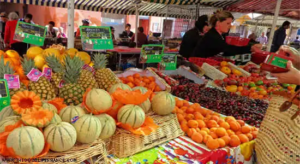Americans have a lot of difficulty with the word, orange. We’re not sure if it’s two syllables or one or whether the first two letters are pronounced ah, aw or oh. With Orange counties in New York, California and Florida, we’re not even sure where it is. So a discussion on Orange, a city in France’s Rhône valley, ought to start with the pronunciation, which is oar-AHNZH, with the r sort of strangled at the back of the throat and the n stuck in the nose.
The city of Orange has a lot of history. First there were the Gauls. Then when Julius Caesar won his war, some Roman veterans set up what became Orange. The name is based on the Gallo-Roman name for the fort that was there and over time it’s morphed into the color we know as the Syracuse University basketball team. Oh, yes, and that fruit of the same name.
The Roman Theater in Orange, in performance. Photo courtesy of All About World Heritage Sites.
There are no Gallic ruins that can be seen but there is a lot of ancient Rome still in Orange that can be visited and admired. The best known is the Roman Theater, still in use for concerts and plays (in French, not Latin). The seating was restored in the 19th century, but the stage – overseen by a statue of the Emperor Augustus – is original. The theater accommodates 10,000 people to this day.
There is also an Arc de Triomphe that had been incorporated into the walls of the medieval city and now stands alone in restored glory. The triumph in question was Caesar’s victory over the Gauls, which does seem a bit like rubbing it in.
Orange sits very much in the midst of Provençal Wine Country. Châteauneuf du Pape is the next town over; Beaume de Venise, Vacqueyras and Gigondas are due east, twenty minutes’ drive on small rural roads. There is no shortage of great wine to be had if you’re in Orange.
The market in Orange. Photo courtesy of The Good Life France.
As wine tasters, you’ll certainly take advantage of travelling through the environs of Orange. But be sure to leave time to enjoy this fine little city. It is much more than ruins. Of course, there’s a museum and a cathedral, as there are in virtually every French town and city. But the people of Orange (Orangians? Orangeois? Orang-utans?) live there in leisure and comfort.
We have had the occasion to shop and cook in Orange, due to the pleasure of having friends there. The chickens are plumper and more flavorsome than we’re used to in America. The bread and pastries are indescribable. And they grow more than grapes in the region around Orange. If you manage to be there on market day, make sure to have some apricots, prune plums, figs and an incredible fruit called mirabelles. They put whatever you buy at your local grocery to shame. And for all you know, they could have been grown in an orchard only a few blocks away.
At those same markets, you can find the fabrics, table cloths, herbs, pottery and honey that Provence is famous for. Take advantage of them while you’re there; you never know when you’ll pass that way again.

